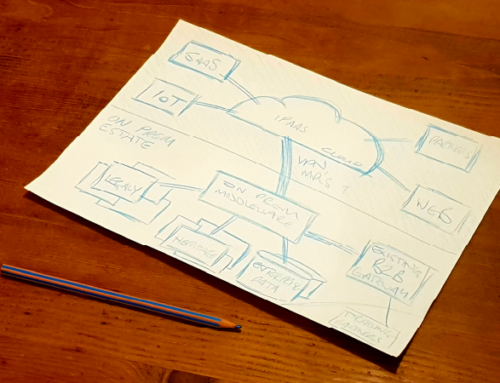Ten Reasons Why You Need an Integration Strategy

At Wheeve, we believe a successful integration capability is built on a strong vision and strategy for achieving it. To me, it’s self evident that, in any field of endeavour, if you don’t take the time to consider where you’re going, you’re unlikely to end up in the right place. At the very least, if you do end up there, you’ll not have taken the most direct and efficient route.
However, few CIOs devote time and effort to develop an integration strategy that works.
A good strategy for integration is vital and in this post I’ve tried to summarise the top ten. Broadly speaking, they fall into three categories:
- Defining where you’re going and making key decisions so that everyone involved, from senior leadership to the engineers that will actually implement your plans, understands what the ‘plan’ is;
- Getting buy-in from the right people – including the budget-holders who will bankroll your initiative, your ‘customers’ whose ways of working will be improved by your proposed capability, and your team, who must understand the overarching plan so they can contribute as effectively and fully as possible;
- Articulating what’s involved so that you can move forward quickly with your plans.
I hope you find this post illuminating and please do let me know what your thoughts are in the comments.
1. Integration is at the Heart of the Modern Enterprise
First off, let’s get this straight: no modern enterprise of any size can function without some sort of integration between their systems. Ten years ago you might have been able to get away without systems integration, but even then, only if you were relatively small and were happy with monolithic systems and a LOT of rekeying of information. Today, you won’t be competitive (and to survive you need to be competitive) if your IT systems aren’t integrated.
The future’s built on data and you need to unlock access to it to make it really work for you.
To maintain your advantage, you need to be looking to new and rapidly evolving technologies: cloud, IoT, AI & deep learning, big data, the extended enterprise to name a few, and none of this stuff works without robust integration to ‘plumb it all together’.
With integration such an important component of your future, surely you should spend some time planning a strategic approach to it?

2. Integration is More Than Technology

Everyone in IT has an integration horror story. I even avoid the term ‘middleware’ these days, not because it’s intrinsically evil, but because its history is littered with failed implementations that never lived up to the hype.
But why is this? Was the technology rubbish? Is middleware inherently unreliable? Does the cost-benefit equation simply not add up?
No. Not at all.
The truth is that the basic principles and patterns of good integration have been well documented for a long time (see Hohpe & Wolfe, and the corresponding service design patterns) and solid enterprise middleware platforms have been around just as long. The issue is that organisation after organisation has made the same mistake: they focussed only on the technology and not on the people and processes that surround it.
Integration was for a long time seen as a very technical engineroom operation and as a result organisations didn’t focus on delivering effective, holistic integration capabilities that were designed to meet their business needs. Left to their own devices, the engineers built things that they thought were right, but didn’t focus on driving maximum business value out of the assets they were using or creating.
So, the Integration Strategy is your opportunity to reset this balance and focus on the ‘whole patient’ – building an integration capability that is not just technology – but people and processes as well.
3. The Marketplace is Complex
Here’s a picture that I enjoy maintaining. It’s a non-exhaustive selection of the many, many technology players in the integration middleware market. By the time you read this article, I’ll bet this picture is out of date. The marketplace is complex and rapidly evolving. Integration is hot and there is a constant stream of new entrants, mergers and acquisitions in the market. And that’s before the marketeers get busy and change the names of your favourite companies and products. As technology evolves new requirements demand new ways of doing things. This means that the development of new products and indeed new product categories, has to be fast.
How can you hope to understand this marketplace and make purchasing decisions that are right for you?
It’s not easy and technology decision-makers can spend forever wrestling with this (by which time the market’s moved on, again!). It’s one of the reasons Mulesoft has done so well. The ‘all things to all people’ approach takes away the pain of the decision – though at considerable cost.
There is no silver bullet here; no substitute for informed analysis, but starting with a well-informed strategy that frames the technology decision as part of a wider capability development will help you narrow down your options.

4. You’ll Need to Ask For Significant Investment

Clients often ask me “How much will it cost?”. It’s a perfectly reasonable question to ask, which I generally decline to give a firm answer until after we’ve done a bit of requirements analysis. Of course every situation is different and there are lots of variables to consider, but experience tells me two things:
(1) The overall cost of an integration capability is much larger than you think it will be. Simply because, as I stated in (2) above, it’s not just about the technology – it’s also about business change and team development which, in my experience, is forgotten in the scope of the initial question.
(2) The overall benefit of a well-designed, implemented and run capability always far outweighs the cost.
Your integration strategy will give you a budgetary answer to the “how much?” question, and also give you an exec-level articulation of the benefits case supporting the investment. And, trust me, that second part will be super-important to justify the investment you” be requesting to get the project off the ground.
5. It Provides Corporate Traceability
As stated in (4) above, developing a strategic integration capability requires investment and for that to be forthcoming, you need to demonstrate the value it will bring. Value judgements don’t exist in a vacuum. It’s not credible simply to say that you will save a load of cash because you’re going to develop reusable APIs.
You’ve got to be able to answer the “So What?” question.
Every organisation has a strategy that defines the direction in which it is heading, and the big-picture initiatives it will undertake to get there. A good integration strategy must dovetail into that and into the IT strategy, showing clearly how the capability supports the wider IT and organisational goals.
In many cases it is possible to show very clearly that effective execution of the wider strategy is simply not possible without integration transformation as a key component. Even when the link is not clear cut the integration strategy can be shown to deliver accelerated progress across all initiatives.

6. It Informs the Wider Enterprise Strategy

Following on from the theme of item (5), integration is such a transformational capability that it often opens up opportunities that materially alter the course of the wider organisational strategy.
This is the heart of digital transformation, which is a core component of most organisation strategies today. A truly digital business looks for new opportunities to deliver improved products and services through technology innovation.
For instance, new products and services, new customer experiences and improved collaborations with partners can be generated when systems data and functionality is liberated using APIs. These new opportunities can open up new avenues for your organisation to explore.
7. It Provides Clear Direction
I mentioned this at the beginning of this article; if you don’t take the time to articulate where you’re going then you’re likely to take a very circuitous route to your destination – and perhaps never reach it. Your integration strategy will define a clear direction of travel, and a path to achieve your envisioned future.
Armed with this knowledge you can:
- Build out an architecture that meets not only your immediate needs but that also puts in place the capabilities you anticipate for the future.
- Ensure you make the most effective purchasing decisions, matching the new tools and technologies you procure to your end goal.
- Avoid blind alleys and the associated cost of rework to eliminate ‘technical debt’.
- Engage with your customers and start to understand the wider impact of the changes to the operating model that you will make…. and many more.
If you make sure everyone is pointing in the direction, you will have much easier ride as you build out the capability, and it’ll be much less costly too.

8. It Educates The Broader Community

I’ve said this many times before, most of your organisation doesn’t understand what integration is, nor do they see much of a need to find out. You get very few opportunities to educate them and show them what a wonderful world you are creating, and how you are going to make their lives better. As a result, it’s often difficult to get the necessary investment to build out the capability.
The strategy is one of your only chances to educate the wider community. Unfortunately, more often than not the only reason you’re getting air time with senior management is because you’re asking for a level of funding that means they’ve got to be involved. Nonetheless, the strategy is your shot at piquing their interested and potentially recruiting one or two influential supporters along the way. That you should take seriously.
9. It Communicates Value
As I said above, you’re looking to convert senior stakeholders to supporters of your integration strategy, and the way to do that is not to show them lots of cool widgets and talk tech. What you need to be explaining is the added value that investment in an integration capability will bring.
I don’t expect it’s clear to them that a strong integration capability will, for example:
- Accelerate, de-risk and reduce the cost of major implementation projects;
- Enable the digital ecosystem by fostering a plug-and-play architecture;
- Unlock data from legacy data sources and enable real-time decision making.
Your mileage may vary in demonstrating the above to the exec team, but we are confident that there will be some value propositions that will strike a resounding chord with them. The strategy is your chance to unearth them and show the organisation what benefits good integration will unlock.

10. It Enables Progress

Finally, when the integration strategy has been set your teams will be free to plan the next stages of the implementation. They will be safe in the knowledge that the direction has been set and they are on the right path. So often we find that implementation teams are slow to find their feet, and this is frequently traced back to higher-level decisions not having been made. If you haven’t set the direction on platform/toolset adoption, team structure, or API approach for example, teams will be unsure how to proceed and lots of time will be wasted with unclear conversations and hearsay.
Setting and communicating the strategy sets the record straight and allows the team to move forward.
In summary
There are many advantages to setting and communicating a clear strategy for integration in your organisation, and it’s so important to your success that we think it’s a n0-brainer to invest some time and thought into defining it properly.
For more detail on how to create a strategy for integration have a look at my article: “What is Integration an Strategy?”.
If you are interested in developing an integration strategy for your organisation Wheeve can help. We offer a cost-effective consulting package and can work with you to develop, document and communicate your vision and strategy. This will save you time and ensure that you get a plan that will be understood, supported and ultimately, funded by senior stakeholders in your organisation. To discuss your requirements contact us by email on [email protected] or call 01923 590095.








